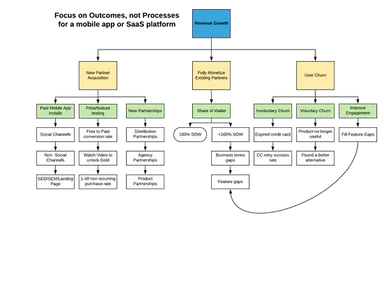6 Things to Look into When Building a Partner Channel Organization


This article was guest written by Christian Gellert, Custom Tailor for Strategic Channel Organizations at www.christiangellert.com
From building awareness through joint collateral to developing new solutions to take to market, and acting as a new revenue pipeline for your business, partners can provide a lot of air cover for startups looking to accelerate their growth. But put together haphazardly, a partner program can backfire easily. While it would be great if you could create a program structure once, and wait for new revenue-generating partnerships to trickle in, it often takes much more effort and patience to kickstart partnership engagement on a programmatic level. With that in mind, here are six things you should look into when building a partner channel.
1. Is your company partner-ready?
Make sure that you completely understand what partnering up means. It’s not only getting leads from partners, make everyone happy with your solution and offer a share in return. It’s about cherishing the relationship that you build with them to create a balanced long term success story for both sides. This involves giving them leads and professional service projects in return so they can be the value add partner you want them to be. All stakeholders in a company need to understand why it is important and where are you heading strategically in partnerships and there should be full commitment from your board members.
2. Is your product partner-ready?
Understanding if and how partners can make money with your product is a core topic for you. The best-case scenario? You achieved product/market, language/market and channel/product fit already, so it is clear for you and the partner where this goes. What connectors to offer depends on the complexity of your product. Build the framework to let partners market your product as affiliates for rather simple products/onboarding journeys. If the complexity is getting bigger, take care to have support documentation/training material to teach the partners, so they can teach the prospects/clients vice versa and implement your solution. Have a clear strategy if you want to have a marketplace and a way to present other products that customers are willing to test and purchase them. Last but not least: Give the partner a chance to earn money with what he does best. Partners are specialists in their own field — that is why you partner with them. Let them consult, integrate and boost your product’s capabilities with their services.
3. Types of partners — where to start?
Sales & Marketing Partners (Referral, Reseller, OEM) Referral partners use their network to spread the word regarding your solution. The job ends here and your direct sales team will take over. For Resellers and OEM partners, you offer a greater flexibility in regards to the sales process and visibility of your brand to the prospect/customer.
Services Partners Know how to sell, implement your product and retain customers. They cover the really important first and last mile, take the load from your whole organization and, if enabled/embedded well in projects, deliver similar to the high standards you have for your own company.
Technology Partners Operate in a segment that makes it easy to combine your solutions for joint selling.
Strategic Partners Global agencies/consultancies that lift your reputation and solution on a higher level and help that you are perceived as a thought leader in your segment
Building up the framework for Sales & Marketing Partners and Services Partners can be your #1 priority in the beginning. The former can produce quick wins with their existing customer base and the latter additionally help you to take the pressure from your product delivery teams when they are put in the right place and support with professional services.
Technology Partners can span a network of complementary solutions and lead to a marketplace environment that adds a new revenue channel to your business.
Strategic Partners mostly take the longest time to be in place but can form a fruitful alliance for both sides with you. Their reputation to be state of the art and innovation-driven increases and you sometimes get the chance to open doors that your direct sales organization can’t. Win-Win.
Give the partner a chance to earn money with what he does best. Partners are specialists in their own field — that is why you partner with them. Let them consult, integrate and boost your product’s capabilities with their services.
4. The people framework
Ideally you have a Director of Partnerships in each of your core markets to start things off. This person should be experienced enough to set everything up, execute based on the global Go-To-Market strategy and open this market without too much guidance. Depending on how complex selling your solution is you should plan to have a Partner Enablement Specialist in place that takes care of increasing the knowledge of partners that are qualified to partner with you with several tools you can offer, such as onsite and remote training, marketing and sales collateral and basic update communication.
5. It’s a numbers game
Based on my experience, partner organizations contribute 10–25% of the ARR at early to mid-stage companies and are roughly making up 3–5% of the company’s workforce. Reaching a conversion between 15–25% from sales accepted opportunities to closed-won business leads to the pipeline you need to produce.
6. What to track
Typically you would look at Sourced Pipeline, Influenced Pipeline and Professional Services delivered by partners. If your product’s deal cycle and implementation time frame is small be sure to additionally measure them on new MRR/ARR.
Sourced Pipeline Leads that a partner brings to you where you get a direct introduction to the prospect. Rule of thumb for average partner organizations is $1mm pipeline generated per Partner Manager per quarter
Influenced Pipeline A deal from another lead source that stalls and needs help. Partner teams can bring partners in a position to bring in other contacts, deal with rejection (sometimes it’s better to have a second/third opinion) or deliver substantial professional services to move on with a deal
Professional Services This is where the magic happens. A lot of partners are not interested in a share as they are highly focussed on selling man-days of the consultants/project managers they have. Help them with this. Having a clear internal strategy if you do professional services yourself and to what extent, helps the partner team to give partners an idea of what’s in for them.
Another important metric to look into is the number of partners per territory and partner type. Based on the plan of your pipeline and ARR you calculate this with the assumption of how much a typical partner can contribute. You need to be aligned with all the departments in your company when it comes to this, as the demand for pipeline and professional services involves different stakeholders. Use these numbers to set up goals for engaging/qualifying (the right) partners involving the maturity of your territories.
Following the “Must-Have Survey” that I learned about in the book “Hacking Growth” (2017, Sean Ellis, Morgan Brown) there are simple questions you can raise. The survey was asking costumers how they would feel, if a product no longer existed tomorrow. Answers rank from “very disappointed” over “Not disappointed (it really isn’t that useful)” to “N/A — I no longer use it”. Transfer this to the product that you are offering — a successful partner program. Ask how the partner would feel if you stop the program tomorrow. How many decision-makers would refer or repeat business, how embedded do they feel, what do they think about the quality of your leads? Cover some of these human/relationship-centric questions and you will understand if there is room for improvement.
Special note: Thanks go out to Shohei Narron, Tai Rattigan, Asher Mathew and all Channel Sales Leaders I could learn from.



